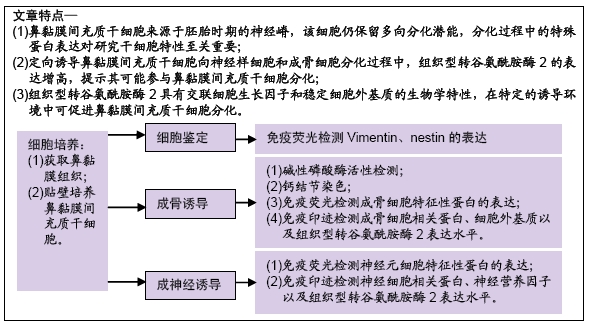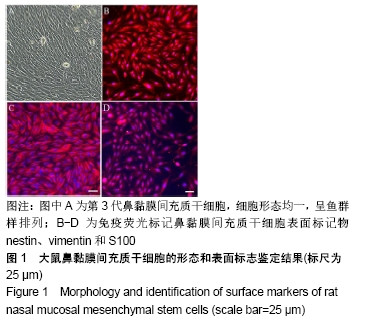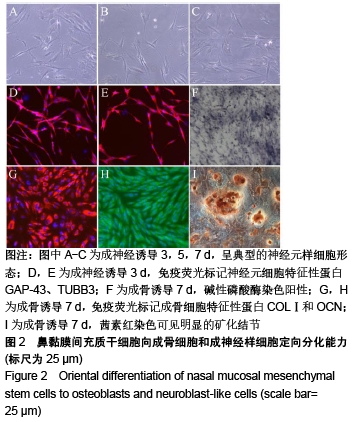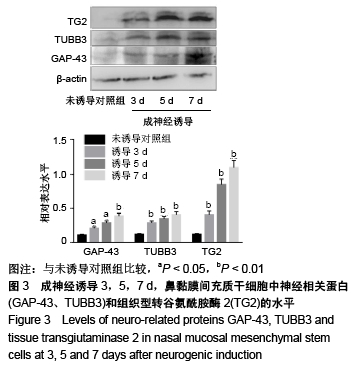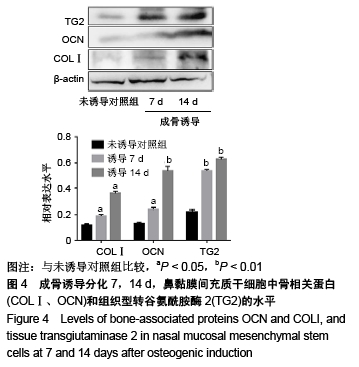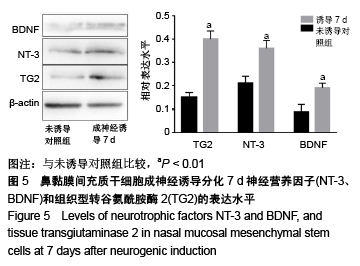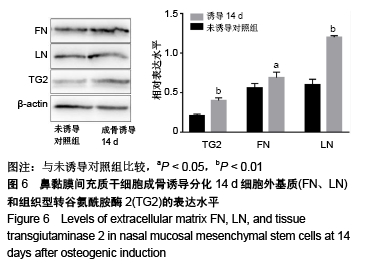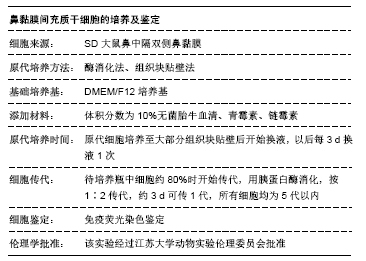[1] ZHANG Z, HE Q, DENG W, et al. Nasal ectomesenchymal stem cells: multi-lineage differentiation and transformation effects on fibrin gels.Biomaterials. 2015;49:57-67.
[2] 黄秋生,陆汉强,周月鹏,等.成人鼻黏膜间充质干细胞的体外培养和多向诱导分化[J].临床耳鼻咽喉头颈外科杂志, 2012,26(11): 490-493,498.
[3] LORAND L, GRAHAM RM.Transglutaminases: crosslinking enzymes with pleiotropic functions.Nat Rev Mol Cell Biol. 2003;4(2):140-156.
[4] LAI TS, LIN CJ, GREENBERG CS.Role of tissue transglutaminase-2 (TG2)-mediated aminylation in biological processes.Amino Acids. 2017;49(3):501-515.
[5] TATSUKAWA H, FURUTANI Y, HITOMI K, et al. Transglutaminase 2 has opposing roles in the regulation of cellular functions as well as cell growth and death.Cell Death Dis. 2016;7(6):e2244.
[6] VANELLA L, RACITI G, BARBAGALLO I, et al. Tissue transglutaminase expression during neural differentiation of human mesenchymal stem cells.CNS NeurolDisord Drug Targets. 2015;14(1):24-32.
[7] KAARTINEN MT, EL-MAADAWY S, RÄSÄNEN NH, et al. Tissue transglutaminase and its substrates in bone.J Bone Miner Res. 2002;17(12):2161-2173.
[8] CHEN Q, ZHANG Z, LIU J, et al. A fibrin matrix promotes the differentiation of EMSCs isolated from nasal respiratory mucosa to myelinating phenotypical Schwann-like cells.Mol Cells. 2015;38(3):221-228.
[9] CHEN Q, ZHOU H, HU P. Stemness distinctions between the ectomesenchymal stem cells from neonatal and adult mice. Acta Histochem. 2017;119(8):822-830.
[10] LI G, LIU J, ZHAO M, et al. SOST, an LNGFR target, inhibits the osteogenic differentiation of rat ectomesenchymal stem cells. Cell Prolif. 2018;51(2):e12412.
[11] DELORME B, NIVET E, GAILLARD J, et al. The human nose harbors a niche of olfactory ectomesenchymal stem cells displaying neurogenic and osteogenic properties. Stem Cells Dev. 2010;19(6):853-866.
[12] LIU J, CHEN Q, ZHANG Z, et al. Fibrin scaffolds containing ectomesenchymal stem cells enhance behavioral and histological improvement in a rat model of spinal cord injury. Cells Tissues Organs. 2013;198(1):35-46.
[13] YIN X, CHEN Z, LIU Z, et al. Tissue transglutaminase (TG2) activity regulates osteoblast differentiation and mineralization in the SAOS-2 cell line.Braz J Med Biol Res. 2012;45(8): 693-700.
[14] ECKERT RL, KAARTINEN MT, NURMINSKAYA M, et al. Transglutaminase regulation of cell function.Physiol Rev. 2014;94(2):383-417.
[15] WANG X, YU Z, ZHOU Q, et al. Tissue transglutaminase-2 promotes gastric cancer progression via the ERK1/2 pathway. Oncotarget. 2016;7(6):7066-7079.
[16] LEE CS, PARK HH. Structural aspects of transglutaminase 2: functional, structural, and regulatory diversity. Apoptosis. 2017;22(9):1057-1068.
[17] CHRISTENSEN B, ZACHARIAE ED, SCAVENIUS C, et al. Transglutaminase 2-Catalyzed Intramolecular Cross-Linking of Osteopontin.Biochemistry. 2016;55(2):294-303.
[18] KIM N, LEE WK, LEE SH, et al. Inter-molecular crosslinking activity is engendered by the dimeric form of transglutaminase 2. Amino Acids. 2017;49(3):461-471.
[19] KAARTINEN MT, PIRHONEN A, LINNALA-KANKKUNEN A, et al. Transglutaminase-catalyzed cross-linking of osteopontin is inhibited by osteocalcin.J Biol Chem.1997;272(36): 22736-22741.
[20] 崔学文,史文涛,戴瑶,等.TG2基因修饰的鼻粘膜间充质干细胞向神经样细胞分化的研究[J].神经解剖学杂志, 2018,34(3): 297-304.
[21] FORSOVA OS, ZAKHAROV VV.High-order oligomers of intrinsically disordered brain proteins BASP1 and GAP-43 preserve the structural disorder.FEBS J. 2016;283(8): 1550-1569.
[22] TISCHFIELD MA, BARIS HN, WU C, et al. Human TUBB3 mutations perturb microtubule dynamics, kinesin interactions, and axon guidance.Cell. 2010;140(1):74-87.
[23] MUKHAMEDSHINA YO, GRACHEVA OA, MUKHUTDINOVA DM, et al. Mesenchymal stem cells and the neuronal microenvironment in the area of spinal cord injury.Neural Regen Res. 2019;14(2):227-237.
[24] SALASZNYK RM, WILLIAMS WA, BOSKEYA,et al. Adhesion to Vitronectin and Collagen I Promotes Osteogenic Differentiation of Human Mesenchymal Stem Cells.J Biomed Biotechnol. 2004;2004(1):24-34.
[25] DUCY P, DESBOIS C, BOYCE B, et al. Increased bone formation in osteocalcin-deficient mice.Nature.1996;382 (6590):448-452.
[26] BESSEY OA, LOWRY OH, BROCK MJ.A method for the rapid determination of alkaline phosphates with five cubic millimeters of serum.J Biol Chem. 1946;164:321-329.
[27] BELLOWS CG, AUBIN JE, HEERSCHe JN, et al. Mineralized bone nodules formed in vitro from enzymatically released rat calvaria cell populations.Calcif Tissue Int. 1986;38(3): 143-154.
[28] ZEMSKOV EA, JANIAK A, HANG J, et al. The role of tissue transglutaminase in cell-matrix interactions.Front Biosci. 2006;11:1057-1076.
[29] JANIAK A, ZEMSKOV EA, BELKIN AM.Cell surface transglutaminase promotes RhoA activation via integrin clustering and suppression of the Src-p190RhoGAP signaling pathway.MolBiol Cell. 2006;17(4):1606-1619.
[30] FAVERMAN L, MIKHAYLOVA L, MALMQUIST J, et al. Extracellular transglutaminase 2 activates beta-catenin signaling in calcifying vascular smooth muscle cells.FEBS Lett. 2008;582(10):1552-1557.
[31] HARSFALVI J, ARATO G, FESUS L.Lipids associated with tissue transglutaminase.BiochimBiophysActa. 1987;923(1): 42-45.
[32] TELCI D, GRIFFIN M.Tissue transglutaminase (TG2)--a wound response enzyme.Front Biosci. 2006;11:867-882.
[33] NURMINSKAYA M, KAARTINEN MT.Transglutaminases in mineralized tissues.Front Biosci. 2006;11:1591-1606.
|
